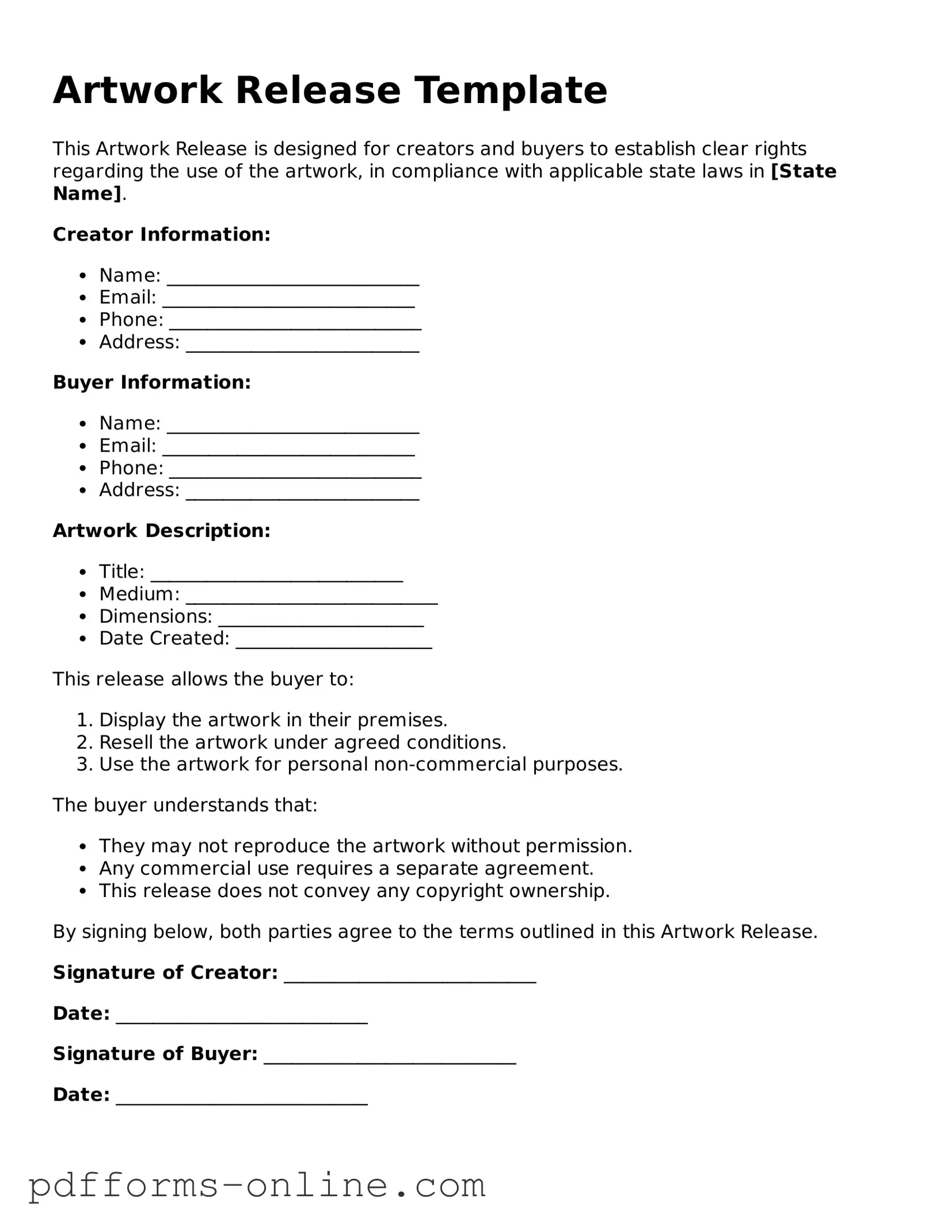The Artwork Release form is similar to a Model Release form. Both documents serve to protect the rights of the parties involved, particularly in creative industries. A Model Release is used when a photographer or artist captures the likeness of a person, allowing them to use that image for commercial purposes. Just like the Artwork Release, it ensures that the individual depicted grants permission for their likeness to be used and that they understand the potential implications of that use.
Another document akin to the Artwork Release form is the Copyright Assignment Agreement. This agreement is crucial for transferring ownership of creative works. In the case of artwork, the creator may choose to assign their copyright to another party, often in exchange for compensation. Both documents emphasize the importance of consent and clarify the rights of the creator versus the rights of the party receiving the work.
The Licensing Agreement is another document that shares similarities with the Artwork Release form. This agreement allows one party to use another party's intellectual property under specified conditions. For instance, an artist may license their artwork for use on merchandise. Like the Artwork Release, it outlines the terms under which the artwork can be used, ensuring that the artist retains certain rights while permitting others to utilize their work.
A Release of Liability form also bears resemblance to the Artwork Release. While it serves a different purpose, both documents aim to protect parties from legal claims. The Release of Liability form is often used in activities that carry risk, ensuring participants understand and accept those risks. Similarly, the Artwork Release protects the artist by clarifying how their work will be used and limiting potential legal repercussions.
The Non-Disclosure Agreement (NDA) is another document that aligns with the principles of the Artwork Release form. An NDA is designed to protect confidential information shared between parties. In creative contexts, artists may share their work or ideas with potential collaborators or clients. The Artwork Release, while focused on usage rights, also implies a level of confidentiality regarding the artist’s work before it is publicly released.
Furthermore, the Partnership Agreement can be compared to the Artwork Release form. This document outlines the terms of collaboration between two or more parties. In artistic collaborations, partners may need to clarify how their contributions will be used and credited. The Artwork Release similarly establishes the parameters of use, ensuring that all parties are on the same page regarding ownership and rights.
The Work-for-Hire Agreement is yet another document that shares similarities with the Artwork Release. This type of agreement is used when a creator produces work on behalf of another party, often as part of their job. The creator typically relinquishes certain rights to the work upon completion. The Artwork Release form, while not strictly a work-for-hire document, also addresses the rights of the creator and the usage of the work, ensuring clarity in the relationship.
Understanding the importance of a comprehensive Release of Liability form can greatly assist individuals and organizations in mitigating risks associated with various activities. This document serves to protect against legal claims by explicitly outlining the terms under which the parties agree to waive their rights to seek damages for any potential injuries or losses incurred during an event or activity.
Additionally, the Creative Commons License can be likened to the Artwork Release form. This license allows creators to specify how others may use their work while retaining some rights. It provides a framework for sharing and protecting creative works, similar to how the Artwork Release outlines the conditions under which artwork can be utilized by others.
Lastly, the Assignment of Rights Agreement also shares common ground with the Artwork Release form. This document details the transfer of specific rights from one party to another. For artists, it may involve assigning certain rights related to their artwork to a publisher or gallery. Both documents emphasize the need for clear communication regarding ownership and usage rights, ensuring that all parties understand their roles and responsibilities.
